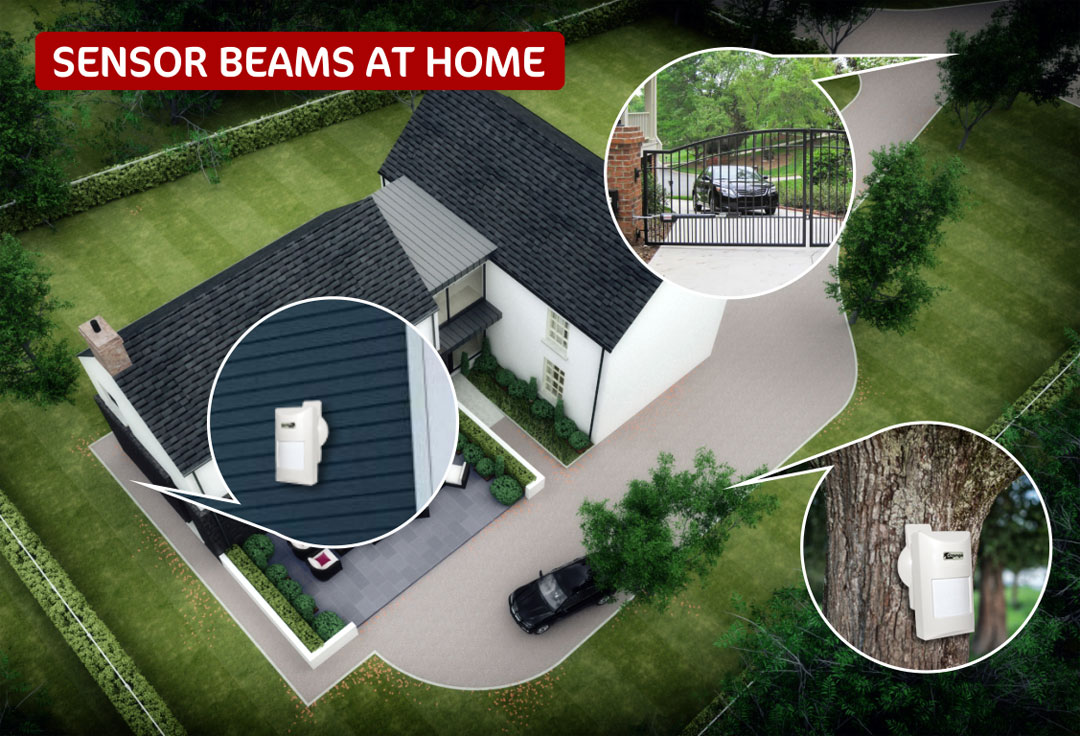Get in touch! +27 (062) 626 1002 | info@drongo.co.za

OUTDOOR SECURITY BEAMS:4 PRO TIPS FOR IDEAL PLACEMENT
Outdoor security beams and other types of outdoor intruder sensors detect intrusions BEFORE they become dangerous. Let's face it: If you wait for your traditional alarm system to trigger, it is already too late.

Introduction
Outdoor security beams and other types of outdoor intruder sensors detect intrusions BEFORE they become dangerous.
Let's face it: If you wait for your traditional alarm system to trigger, it is already too late. By the time you wake up, they are already in your home, perhaps with a knife at your throat.
Most outdoor security beams are designed to be installed against the outside walls of a house, and detect movement when the intruder is already very close to the residence. This is typically because these sensors are hard-wired to the alarm system, and installing them right at the house makes the wiring job so much easier.
Let's face it: If you wait for your traditional alarm system to trigger, it is already too late. By the time you wake up, they are already in your home, perhaps with a knife at your throat.
Most outdoor security beams are designed to be installed against the outside walls of a house, and detect movement when the intruder is already very close to the residence. This is typically because these sensors are hard-wired to the alarm system, and installing them right at the house makes the wiring job so much easier.
1.) Detect an intruder as early as possible
Outdoor security beams in close proximity to the house are better than nothing, but it is best to detect an intruder as early as possible, even before he is able to get close to the home.
For this purpose, it helps if your outdoor security beams are wireless, and especially if they have significant range. The Drongo outdoor security beams are a great example of this. Your point of detection can now be on the perimeter of the property, giving you much better insight into the intrusion.
For this purpose, it helps if your outdoor security beams are wireless, and especially if they have significant range. The Drongo outdoor security beams are a great example of this. Your point of detection can now be on the perimeter of the property, giving you much better insight into the intrusion.
2.) Tactical placement
Some properties are quite large, and on the surface may appear to require a few crates of sensors to effectively monitor, but this is not necessarily the case. Each property has it's unique quirks.
From a tactical point of view, one can easily figure out from what direction an intrusion is likely and which route to the house will present the lowest amount of risk to an intruder.
3.) Wall or fence security
Simply put yourself into the intruder's shoes and think about it.
The intruder will obviously first have to cross your outer boundary fence or wall.
Which walls or fences give the best access to your property? - those are the ones you want to cover first with an outdoor security beam.
It would make sense to purposely create one or two areas of fence or wall where access is much easier than anywhere else on the perimeter. Your intruder will typically follow the path of least resistance and go for those easy access points. It is then a simple matter to install outdoor security beams at those easy access points. This way you can sometimes cover huge perimeter areas very effectively.
It would make sense to purposely create one or two areas of fence or wall where access is much easier than anywhere else on the perimeter. Your intruder will typically follow the path of least resistance and go for those easy access points. It is then a simple matter to install outdoor security beams at those easy access points. This way you can sometimes cover huge perimeter areas very effectively.
4.) Considering your garden layout
Let us assume they make it inside your perimeter. Once there, they will prefer to immediately find some cover, preferably at a location where they have an ideal view of the house. Here they can collect themselves and check out the place at their leisure. It is for this reason that it makes sense to change your garden layout such that there are only 1 or 2 good hiding places available, and then place sensors to detect movement at those "hot spots". Remove all other possible hiding spots like large bushes or garden features that may be used as hiding spots.
It is true that by selectively placing your outdoor security beams as explained above, you are creating some "soft" areas where an intruder can enter without detection, but remember: The intruder does not know where your outdoor security beams are located, nor are they aware when they are detected! No freestanding house should be without basic outdoor security beam coverage. You need to be alert today in order to be alive tomorrow!
It is true that by selectively placing your outdoor security beams as explained above, you are creating some "soft" areas where an intruder can enter without detection, but remember: The intruder does not know where your outdoor security beams are located, nor are they aware when they are detected! No freestanding house should be without basic outdoor security beam coverage. You need to be alert today in order to be alive tomorrow!
